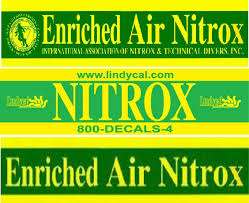
Many divers I talk to or over hear in conversation often think that Nitrox is used for deep diving, this in fact is the biggest misconception for scuba diving in Roatan. In fact the deeper you dive the less oxygen is needed in the cylinders, to maintain a safe partial pressure of 1.4ATA on bottom.
The first evidence of a dive using enriched air in 1879 by Henry Fleuss, who was a master diver for Siebe Gorman & Co. of London. He was breathing a mixture of 50 to 60 % oxygen enriched air in a large fresh water tank, a week later he logged a dive in open water with the same mix and equipment. Siebe continued his research into Nitrox mixes and between the two World Wars he introduced the technique of using different concentrations of oxygen mixed with nitrogen. This was used to great effect by British commandos during World War Two who used oxygen-enriched air rebreathers. Their rebreathers used a mix of 45 to 60% oxygen which had a greater maximum operating depth than their opponents who used pure oxygen rebreathers were limited to 6mt / 20ft.
If we breathe Nitrox during our dive we gain significant bottom time before we reach our no-stop time. The exact amount of extra bottom time will depend on the depth that we are diving to and the Nitrox mix that we are breathing.
So for an air dive to 30mt / 100ft the partial pressure of nitrogen during the dive is
4 x 0.79 = 3.16bar. If we are breathing Nitrox with a 32% oxygen content (and 68% nitrogen) then the partial pressure of nitrogen is 4 x 0.68 = 2.72 bar.
So as the inspired partial pressure is lower when breathing EAN32, the tissues will on-gas slower at any point the same tissue will contain less nitrogen than if the diver had been breathing air. Oh one other thing, it makes you look COOL!!!

What will you learn in your Nitrox theory?

History of Enriched Air Nitrox (EAN)
Physiology
Oxygen
Nitrogen
Physics
Pressure review
Partial pressures
Equipment Considerations
Forty percent oxygen content and less
Above 40 percent oxygen content
Dive Tables
Equivalent air depth (EAD) introduction of concept only for demonstration
EAN tables
Switching mixes on repetitive dives
Dive Computers
Mix adjustable
Oxygen (O2) integrated
Advantages and Disadvantages on scuba diving in Roatan on Enriched Air.
Use as air for physiological advantage with air tables or computers
Use to extend no-decompression bottom times or shorten surface intervals
Oxygen toxicity hazards and depth limits
Discussion of myths and facts regarding EAN mixtures
Procedures
Use and theory of oxygen analyzer
Gas analysis and logging
Common Mixing Procedures
Partial pressure blending
Continuous blending
Membrane separation system
Why use Nitrox while scuba diving in Roatan?


Travel out to the other shipwreck further up the coast “Odyssey” and explore the triple decker super structure on Nitrox. Again spend up to 35 min or so enjoying the large wreck without being pushed by no-deco limits of air.



